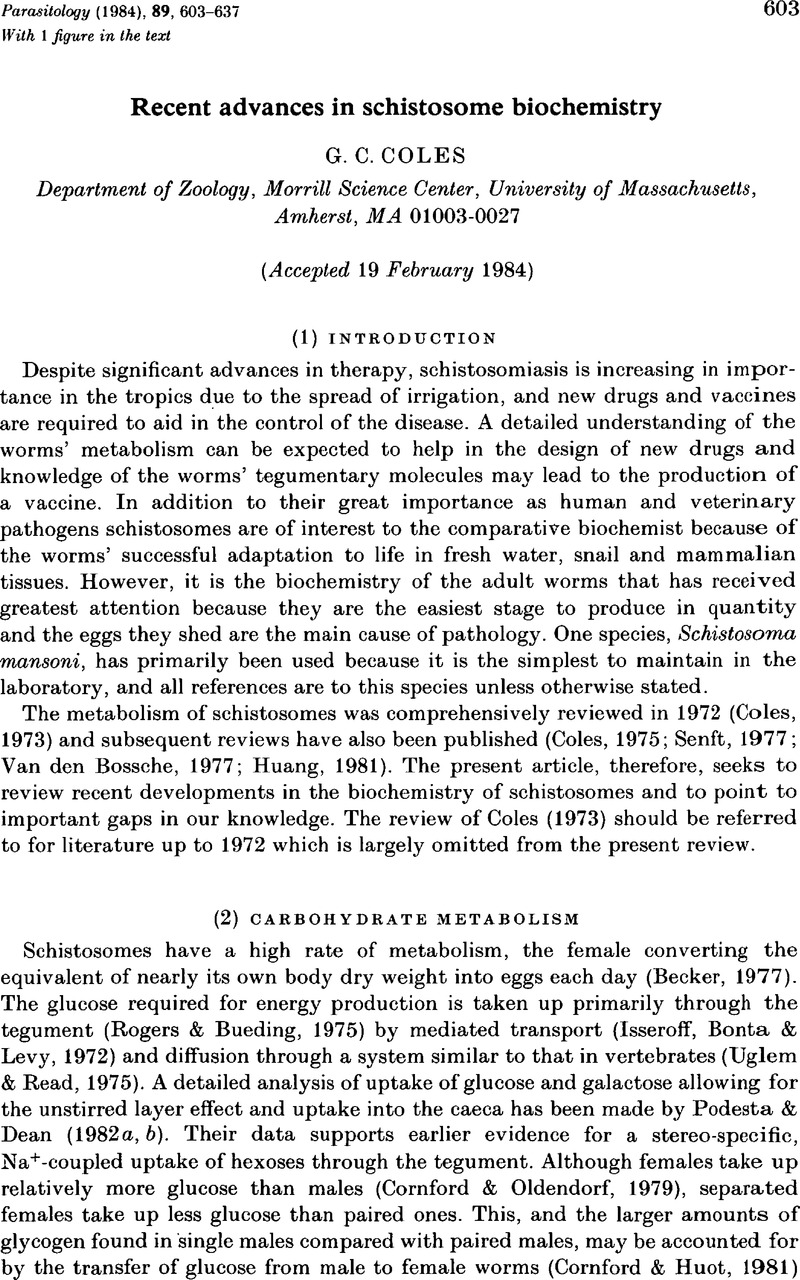Crossref Citations
This article has been cited by the following publications. This list is generated based on data provided by Crossref.
Bossche, H. Vanden
1985.
How anthelmintics help us to understand helminths.
Parasitology,
Vol. 90,
Issue. 4,
p.
675.
Shaw, Michael K.
1986.
Elemental changes during sexual maturation inSchistosoma mansoni.
Journal of Chemical Ecology,
Vol. 12,
Issue. 8,
p.
1765.
CHENG, THOMAS C.
1986.
General Parasitology.
p.
299.
Coles, G.C.
and
Bruce, J.I.
1987.
In vitro selection of drug resistant Schistosoma mansoni.
International Journal for Parasitology,
Vol. 17,
Issue. 3,
p.
767.
McManus, D.P.
1987.
Intermediary metabolism in parasitic helminths.
International Journal for Parasitology,
Vol. 17,
Issue. 1,
p.
79.
Shaw, M. K.
and
Erasmus, D. A.
1987.
Schistosoma mansoni: structural damage and tegumental repair after in vivo treatment with praziquantel.
Parasitology,
Vol. 94,
Issue. 2,
p.
243.
Köhler, P.
and
Voigt, W. P.
1988.
Parasitology in Focus.
p.
412.
Arme, C.
1988.
Ontogenetic changes in helminth membrane function.
Parasitology,
Vol. 96,
Issue. S1,
p.
S83.
Rumjanek, Franklin David
Campos, Elida Geralda
and
Luis Carlos, Crocco Afonso
1988.
Evidence for the occurrence of LDL receptors in extracts of schistosomula of Schistosoma mansoni.
Molecular and Biochemical Parasitology,
Vol. 28,
Issue. 2,
p.
145.
Van Oordt, B. E. P.
Tielens, A. G. M.
and
Van Den Bergh, S. G.
1989.
Aerobic to anaerobic transition in the carbohydrate metabolism of Schistosoma mansoni cercariae during transformation in vitro.
Parasitology,
Vol. 98,
Issue. 3,
p.
409.
McManus, D. P.
1989.
Comparative Biochemistry of Parasitic Helminths.
p.
79.
Coles, Gerald C.
1989.
Comparative Biochemistry of Parasitic Helminths.
p.
125.
Xu, Yi-zheng
Shawar, Said M.
and
Dresden, Marc H.
1990.
Schistosoma mansoni: Purification and characterization of a membrane-associated leucine aminopeptidase.
Experimental Parasitology,
Vol. 70,
Issue. 2,
p.
124.
Horemans, A. M. C.
Tielens, A. G. M.
and
Van Den Bergh, S. G.
1991.
The transition from an aerobic to an anaerobic energy metabolism in transforming Schistosoma mansoni cercariae occurs exclusively in the head.
Parasitology,
Vol. 102,
Issue. 2,
p.
259.
Barrett, J.
1994.
Helminthology.
p.
211.
Camacho, Marcela
Alsford, Samuel
Jones, Andrea
and
Agnew, Alison
1995.
Nicotinic acetylcholine receptors on the surface of the blood fluke Schistosoma.
Molecular and Biochemical Parasitology,
Vol. 71,
Issue. 1,
p.
127.
Barrett, John
2000.
Echinostomes as Experimental Models for Biological Research.
p.
199.
Hoffmann, Karl F
Johnston, David A
and
Dunne, David W
2002.
Identification of Schistosoma mansonigender-associated gene transcripts by cDNA microarray profiling.
Genome Biology,
Vol. 3,
Issue. 8,
Dalton, John P
Skelly, Patrick
and
Halton, David W
2004.
Role of the tegument and gut in nutrient uptake by parasitic platyhelminths.
Canadian Journal of Zoology,
Vol. 82,
Issue. 2,
p.
211.
Marques, Heloisa H.
Zouain, Claudia S.
Torres, Cristiane B.B.
Oliveira, Jamil S.
Alves, José B.
and
Goes, Alfredo M.
2008.
Protective effect and granuloma down-modulation promoted by RP44 antigen a fructose 1,6 bisphosphate aldolase of Schistosoma mansoni.
Immunobiology,
Vol. 213,
Issue. 5,
p.
437.



